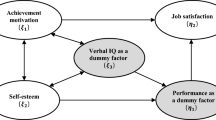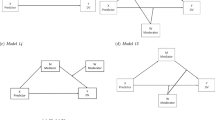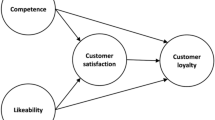Abstract
PLSe1 and PLSe2 methods were developed in 2013. While the performance of PLSe1 under normality and non-normality conditions has been confirmed, the performance of PLSe2, proposed to provide an avenue for the resurrection of PLS as a fully justified statistical methodology, has not yet been verified under non-normality condition. For this reason, our study aims at testing the performance of PLSe2 with non-normal data based on a Monte Carlo simulation using a simple and a complex model. In addition, it aims at providing a step-by-step visual guideline on how to apply this method in estimating a simple mediation model using EQS 6.4. The results of the Monte Carlo simulations across different numbers of replications and sample sizes provided substantial support for the performance of PLSe2 under non-normality conditions since the produced estimates were unbiased and virtually identical to the parameters resulted from the traditional ML estimation. In addition, we provided evidence about the suitability of different robust test statistics for the purpose of model evaluation based on our simulation results. Regarding the empirical example, we estimated a mediation model using ML, PLSe2, and PLSc estimators, compared the results across these methods, and provided further support for our PLSe2 and ML results through running a resampling bootstrap simulation. Overall, while we empirically validated the PLSe2 method using Monte Carlo simulations, our findings suggest that PLSe2 has the advantages of both ML and PLS and performs well under non-normality (and normality) conditions, thereby suggesting it as the methodology of choice for model specification, estimation, and evaluation in social sciences empirical studies.














Similar content being viewed by others
Data availability
The data that support the findings of the empirical example in this study are openly available in HARVARD DATAVERSE at https://doi.org/10.7910/DVN/TNGALP.
Notes
In the measurement model displayed in matrix format, ηi are factors; λi,j are factor loadings; yi are equations for the items; and εi are the residuals of the equations.
In the structural model displayed in matrix format, ηi are factors; βi,j are path coefficients; and ζi are disturbance terms of the equations.
EQS supports model-based and resampling bootstrap simulations (Bentler 2006). The procedure of running the resampling bootstrap simulations has not been illustrated as they were not the core objective of this study. However, no convergence problems occurred in the replications (100% success with no condition code).
References
Becker, J.-M., Klein, K., Wetzels, M.: Hierarchical latent variable models in PLS-SEM: guidelines for using reflective-formative type models. Long Range Plan. 45(5–6), 359–394 (2012). https://doi.org/10.1016/j.lrp.2012.10.001
Becker, J.-M., Rai, A., Ringle, C.M., Völckner, F.: Discovering unobserved heterogeneity in structural equation models to avert validity threats. MIS Q. 37(3), 665–694 (2013)
Benitez, J., Henseler, J., Castillo, A., Schuberth, F.: How to perform and report an impactful analysis using partial least squares: guidelines for confirmatory and explanatory IS research. Inf. Manag. (2019). https://doi.org/10.1016/j.im.2019.05.003
Benitez, J., Henseler, J., Roldán, J.L.: How to address endogeneity in partial least squares path modeling. Paper presented at the Twenty-Second Americas Conference on Information Systems, San Diego (2016)
Bentler, P.M.: Multivariate analysis with latent variables: causal modeling. Annu. Rev. Psychol. 31(1), 419–456 (1980). https://doi.org/10.1146/annurev.ps.31.020180.002223
Bentler, P.M.: EQS 6 structural equations program manual. Multivariate Software, Inc, Encino, CA (2006)
Bentler, P.M., Dijkstra, T.K.: Efficient estimation via linearization in structural models. In: Krishnaiah, P.R. (ed.) Multivariate Analysis, pp. 9–42. North-Holland, Amsterdam (1985)
Bentler, P.M., Huang, W.: On components, latent variables, PLS and simple methods: reactions to Rigdon’s rethinking of PLS. Long Range Plan. 47(3), 138–145 (2014). https://doi.org/10.1016/j.lrp.2014.02.005
Bernerth, J.B., Aguinis, H.: A critical review and best-practice recommendations for control variable usage. Pers. Psychol. 69(1), 229–283 (2016). https://doi.org/10.1111/peps.12103
Blunch, N.J.: Introduction to Structural Equation Modeling Using IBM SPSS Statistics and EQS. Sage, Thousand Oaks, CA (2016)
Browne, M.W.: Generalized least squares estimators in the analysis of covariance structures. S. Afr. Stat. J. 8, 1–24 (1974)
Browne, M.W.: Asymptotically distribution-free methods for the analysis of covariance structures. Br. J. Math. Stat. Psychol. 37(1), 62–83 (1984). https://doi.org/10.1111/j.2044-8317.1984.tb00789.x
Bryant, F.B., Satorra, A.: Principles and practice of scaled difference chi square testing. Struct. Equ. Model. Multidiscip. J. 19(3), 372–398 (2012). https://doi.org/10.1080/10705511.2012.687671
Byrne, B.M.: Structural Equation Modeling with EQS: Basic Concepts, Applications, and Programming, 2nd edn. Lawrence Erlbaum Associates, London (2006)
Byrne, B.M.: Structural EQUATION MODELING with AMOS: Basic concepts, Applications, and Programming, 3rd edn. Routledge, New York (2016)
Cassel, C.M., Hackl, P., Westlund, A.H.: On measurement of intangible assets: a study of robustness of partial least squares. Total Qual. Manag. 11(7), 897–907 (2000). https://doi.org/10.1080/09544120050135443
Chan, S.C.H., Mak, W.: The impact of servant leadership and subordinates’ organizational tenure on trust in leader and attitudes. Pers. Rev. 43(2), 272–287 (2014). https://doi.org/10.1108/pr-08-2011-0125
Chin, W.W.: The partial least squares approach to structural equation modeling. In: Marcoulides, G.A. (ed.) Modern Methods for Business Research, pp. 295–358. Lawrence Erlbaum, Mahwah, NJ (1998)
Chou, C.-P., Bentler, P.M., Satorra, A.: Scaled test statistics and robust standard errors for non-normal data in covariance structure analysis: a Monte Carlo study. Br. J. Math. Stat. Psychol. 44(2), 347–357 (1991). https://doi.org/10.1111/j.2044-8317.1991.tb00966.x
Ciavolino, E., Carpita, M., Nitti, M.: High-order PLS path model with qualitative external information. Qual. Quant. 49(4), 1609–1620 (2015). https://doi.org/10.1007/s11135-014-0068-x
Creswell, J.W.: Educational Research: Planning, Conducting, and Evaluating Quantitative and Qualitative Research, 4th edn. Pearson Education Inc, Boston (2012)
Curran, P.J., West, S.G., Finch, J.F.: The robustness of test statistics to nonnormality and specification error in confirmatory factor analysis. Psychol. Methods 1(1), 16–29 (1996)
Dijkstra, T.K.: Some comments on maximum likelihood and partial least squares methods. J. Econom. 22(1), 67–90 (1983). https://doi.org/10.1016/0304-4076(83)90094-5
Dijkstra, T.K.: Consistent partial least squares estimators for linear and polynomial factor models: a report of a belated, serious and not even unsuccessful attempt. Unpublished manuscript (2011)
Dijkstra, T.K., Henseler, J.: Consistent and asymptotically normal PLS estimators for linear structural equations. Comput. Stat. Data Anal. 81, 10–23 (2015a)
Dijkstra, T.K., Henseler, J.: Consistent partial least squares path modeling. MIS Q. 39(2), 297–316 (2015b)
Eichhorn, B.R.: Common method variance techniques. Paper presented at the MWSUG 2014, Chicago, Illinois, October 5–7 (2014)
Evermann, J., Tate, M.: Assessing the predictive performance of structural equation model estimators. J. Bus. Res. 69(10), 4565–4582 (2016). https://doi.org/10.1016/j.jbusres.2016.03.050
Finney, S.J., DiStefano, C.: Non-normal and categorical data in structural equation modeling. In: Hancock, G.R., Mueller, R.O. (eds.) Structural Equation Modeling: A Second Course, pp. 269–314. Information Age Publishing, Greenwich, CT (2006)
Fornell, C., Larcker, D.F.: Evaluating structural equation models with unobservable variables and measurement error. J. Mark. Res. 18(1), 39–50 (1981). https://doi.org/10.2307/3151312
Garson, G.D.: Hierarchical Linear Modeling: Guide and Applications. SAGE Publications, Thosand Oaks (2013)
Ghasemy, M., Sufean, H., Ahmad Zabidi, A.R., Mohd Jamil, M., Ghavifekr, S.: Determining the key capacities of effective leaders in Malaysian public and private focused universities. SAGE Open 8(4), 1–12 (2018). https://doi.org/10.1177/2158244018807620
Ghasemy, M., Sufean, H., Megat Ahmad Kamaluddin, M.D.: The key determinants of leadership performance effectiveness in public research and comprehensive universities: An advanced PLS-SEM study in Malaysian context. Malays. Online J. Educ. Manag. 5(1), 62–81 (2017a). https://doi.org/10.22452/mojem.vol5no1.5
Ghasemy, M., Sufean, H., Megat Ahmad Kamaluddin, M.D., Ahmad Zabidi, A.R., Mohd Jamil, M.: Pivotal qualities for effective university leadership on the basis of a modified Australian model: the application of FIMIX-PLS and IPMA in the Malaysian academic context. Asia Pac. Educ. Rev. 18(4), 501–517 (2017b). https://doi.org/10.1007/s12564-017-9504-7
Goodhue, D.L., Lewis, W., Thompson, R.: Does PLS have advantages for small sample size or non-normal data? MIS Q. 36, 981–1001 (2012)
Grace, J.B., Bollen, K.A.: Representing general theoretical concepts in structural equation models: the role of composite variables. Environ. Ecol. Stat. 15(2), 191–213 (2008)
Gregor, S.: The nature of theory in information systems. MIS Q. 40, 611–642 (2006)
Hair, J.F., Babin, B.J., Anderson, R.E., Black, W.C.: Multivariate Data Analysis, 8th edn. Cengage, Mason, OH (2018)
Hair, J.F., Hult, G.T.M., Ringle, C.M., Sarstedt, M.: A Primer on Partial Least Squares Structural Equation Modeling (PLS-SEM), 2nd edn. Sage, Thousand Oaks, CA (2017a)
Hair, J.F., Hult, G.T.M., Ringle, C.M., Sarstedt, M., Thiele, K.O.: Mirror, mirror on the wall: a comparative evaluation of composite-based structural equation modeling methods. J. Acad. Mark. Sci. 45(5), 616–632 (2017b). https://doi.org/10.1007/s11747-017-0517-x
Hair, J.F., Risher, J.J., Sarstedt, M., Ringle, C.M.: When to use and how to report the results of PLS-SEM. Eur. Bus. Rev. 31(1), 2–24 (2019a). https://doi.org/10.1108/ebr-11-2018-0203
Hair, J.F., Sarstedt, M., Matthews, L.M., Ringle, C.M.: Identifying and treating unobserved heterogeneity with FIMIX-PLS: part I—method. Eur. Bus. Rev. 28(1), 63–76 (2016). https://doi.org/10.1108/ebr-09-2015-0094
Hair, J.F., Sarstedt, M., Ringle, C.M.: Rethinking some of the rethinking of partial least squares. Eur. J. Mark. 53(4), 566–584 (2019b). https://doi.org/10.1108/ejm-10-2018-0665
Henseler, J., Ringle, C.M., Sarstedt, M.: Testing measurement invariance of composites using partial least squares. Int. Mark. Rev. 33(3), 405–431 (2016). https://doi.org/10.1108/imr-09-2014-0304
Huang, W.: PLSe: Efficient Estimators and Tests for Partial Least Square. UCLA, Los Angeles (2013)
Hult, G.T.M., Hair, J.F., Proksch, D., Sarstedt, M., Pinkwart, A., Ringle, C.M.: Addressing endogeneity in international marketing applications of partial least squares structural equation modeling. J. Int. Mark. 26(3), 1–21 (2018). https://doi.org/10.1509/jim.17.0151
Judge, T.A., Thoresen, C.J., Bono, J.E., Patton, G.K.: The job satisfaction–job performance relationship: a qualitative and quantitative review. Psychol. Bull. 127(3), 376–407 (2001). https://doi.org/10.1037//0033-2909.I27.3.376
Kline, R.B.: Principles and Practice of Structural Equation Modeling, 4th edn. Guilford Publications, New York, NY (2016)
Liden, R.C., Wayne, S.J., Zhao, H., Henderson, D.: Servant leadership: development of a multidimensional measure and multi-level assessment. Leadersh. Q. 19(2), 161–177 (2008). https://doi.org/10.1016/j.leaqua.2008.01.006
Macdonald, S., Maclntyre, P.: The generic job satisfaction scale. Empl. Assist. Q. 13(2), 1–16 (1997)
Marcoulides, G.A., Chin, W.W., Saunders, C.: When imprecise statistical statements become problematic: a response to Goodhue, Lewis, and Thompson. MIS Q. 36(2), 717–728 (2012)
Mardia, K.V.: Measures of multivariate skewness and kurtosis with applications. Biometrika 57(3), 519–530 (1970). https://doi.org/10.1093/biomet/57.3.519
Mardia, K.V.: Applications of some measures of multivariate skewness and kurtosis in testing normality and robustness studies. Sankhyā Indian J. Stat. Ser. B (1960–2002) 36(2), 115–128 (1974)
Maruyama, G., McGarvey, B.: Evaluating causal models: an application of maximum-likelihood analysis of structural equations. Psychol. Bull. 87(3), 502–512 (1980). https://doi.org/10.1037/0033-2909.87.3.502
Matthews, L.M., Sarstedt, M., Hair, J.F., Ringle, C.M.: Identifying and treating unobserved heterogeneity with FIMIX-PLS: part II—a case study. Eur. Bus. Rev. 28(2), 208–224 (2016). https://doi.org/10.1108/ebr-09-2015-0095
Miller, J.S., Cardy, R.L.: Self-monitoring and performance appraisal: rating outcomes in project teams. J. Organ. Behav. 21(6), 609–626 (2000). https://doi.org/10.1002/1099-1379(200009)21:6%3c609:aid-job42%3e3.0.co;2-k
Neubert, M.J., Hunter, E.M., Tolentino, R.C.: A servant leader and their stakeholders: when does organizational structure enhance a leader’s influence? Leadersh. Q. 27(6), 896–910 (2016). https://doi.org/10.1016/j.leaqua.2016.05.005
Nitti, M., Ciavolino, E.: A deflated indicators approach for estimating second-order reflective models through PLS-PM: an empirical illustration. J. Appl. Stat. 41(10), 2222–2239 (2014). https://doi.org/10.1080/02664763.2014.909786
Northouse, P.G.: Leadership: Theory and Practice, 6th edn. Sage, Thousand Oaks, CA (2013)
Rhemtulla, M., van Bork, R., Borsboom, D.: Worse than measurement error: Consequences of inappropriate latent variable measurement models. Psychol. Methods 25, 30–45 (2018)
Rigdon, E.E.: Choosing PLS path modeling as analytical method in European management research: a realist perspective. Eur. Manag. J. 34(6), 598–605 (2016). https://doi.org/10.1016/j.emj.2016.05.006
Rigdon, E.E., Becker, J.-M., Sarstedt, M.: Parceling can not reduce factor indeterminacy in factor analysis: a research note. Psychometrika 84(3), 772–780 (2019). https://doi.org/10.1007/s11336-019-09677-2
Ringle, C.M., Sarstedt, M.: Gain more insight from your PLS-SEM results: the importance-performance map analysis. Ind. Manag. Data Syst. 116(9), 1865–1886 (2016). https://doi.org/10.1108/imds-10-2015-0449
Ringle, C.M., Wende, S., Becker, J.-M.: SmartPLS (2015). http://www.smartpls.com
Rönkkö, M., Ylitalo, J.: Construct validity in partial least squares path modeling. In: International Conference on Information Systems (ICIS) (2010)
Sarstedt, M., Hair, J.F., Cheah, J.-H., Becker, J.-M., Ringle, C.M.: How to specify, estimate, and validate higher-order constructs in PLS-SEM. Australas. Mark. J. (AMJ) 27(3), 197–211 (2019). https://doi.org/10.1016/j.ausmj.2019.05.003
Sarstedt, M., Hair, J.F., Nitzl, C., Ringle, C.M., Howard, M.C.: Beyond a tandem analysis of SEM and PROCESS: use of PLS-SEM for mediation analyses! Int. J. Mark. Res. 62(3), 288–299 (2020). https://doi.org/10.1177/1470785320915686
Sarstedt, M., Hair, J.F., Ringle, C.M., Thiele, K.O., Gudergan, S.P.: Estimation issues with PLS and CBSEM: where the bias lies! J. Bus. Res. 69(10), 3998–4010 (2016). https://doi.org/10.1016/j.jbusres.2016.06.007
Satorra, A., Bentler, P.M.: Scaling corrections for Chi square statistics in covariance structure analysis. In: Proceedings of the American Statistical Association, Business and Economic Statistics Section, Washington, DC, pp. 308–313. American Statistical Association (1988)
Satorra, A., Bentler, P.M.: Corrections to test statistics and standard errors in covariance structure analysis. In: Eye, A.V., Clogg, C.C. (eds.) Latent Variable Analysis: Application for Development Research, pp. 399–419. Sage, Thousand Oaks, CA (1994)
Satorra, A., Bentler, P.M.: A scaled difference Chi square test statistic for moment structure analysis. Psychometrika 66(4), 507–514 (2001). https://doi.org/10.1007/bf02296192
Satorra, A., Bentler, P.M.: Ensuring positiveness of the scaled difference Chi square test statistic. Psychometrika 75(2), 243–248 (2010). https://doi.org/10.1007/s11336-009-9135-y
Schermerhorn, J.R., Hunt, J.G., Osborn, R.N., Uhl-Bien, M.: Organizational Behavior, 11th edn. Wiley, Hoboken, NJ (2010)
Schneider, S.K., George, W.M.: Servant leadership versus transformational leadership in voluntary service organizations. Leadersh. Organ. Dev. J. 32(1), 60–77 (2011). https://doi.org/10.1108/01437731111099283
Schuberth, F., Henseler, J., Dijkstra, T.K.: Confirmatory composite analysis. Front. Psychol. 9, 1–14 (2018). https://doi.org/10.3389/fpsyg.2018.02541
Shmueli, G., Sarstedt, M., Hair, J.F., Cheah, J.-H., Hiram, T., Vaithilingam, S., Ringle, C.M.: Predictive model assessment in PLS-SEM: guidelines for using PLSpredict. Eur. J. Mark. 53(11), 2322–2347 (2019). https://doi.org/10.1108/ejm-02-2019-0189
Treiblmaier, H., Bentler, P.M., Mair, P.: Formative constructs implemented via common factors. Struct. Equ. Model. 18(1), 1–17 (2011)
Vinzi, V.E., Trinchera, L., Amato, S.: PLS Path Modeling: From Foundations to Recent Developments and Open Issues for Model Assessment and Improvement. In: Esposito Vinzi, V., Chin, W.W., Henseler, J., Wang, H. (eds.) Handbook of Partial Least Squares: Concepts, Methods and Applications, pp. 47–82. Springer, Berlin (2010)
Wold, H.: Soft modeling: the basic design and some extensions. In: Joreskog, K.G., Wold, H. (eds.) Systems under indirect observation: causality, structure, prediction, vol. 2, pp. 1–54. North-Holland, Amsterdam (1982)
Yuan, K.-H., Bentler, P.M.: Mean and covariance structure analysis: theoretical and practical improvements. J. Am. Stat. Assoc. 92(438), 767–774 (1997). https://doi.org/10.1080/01621459.1997.10474029
Acknowledgements
We appreciate the support of our families to finish this manuscript during unprecedented global crises and workplace upheaval. We also are indebted to the editor and review team for their efforts and contributions during this time. Similarly, we appreciate the responsive support of the technical team at Multivariate Software Inc. (www.mvsoft.com). A part of this project was presented at International Symposium on Applied Structural Equation Modeling and Methodological Matters (SASEM) 2019, Melaka, Malaysia.
Funding
This research study was supported by the Universiti Sains Malaysia (Grant Number: 304/CIPPTN/6315200).
Author information
Authors and Affiliations
Corresponding author
Ethics declarations
Conflict interest
No conflict of interested declared by the authors with respect to the research, authorship, and/or publication of this article.
Additional information
Publisher's Note
Springer Nature remains neutral with regard to jurisdictional claims in published maps and institutional affiliations.
Appendices
Appendix A
The univariate skewness and kurtosis statistics of the items of the simulated 2-factor CFA model under the non-normality condition.
Item | Skewness | Kurtosis |
|---|---|---|
λ1,1 | − 1.75 | 4.00 |
λ2,1 | 1.50 | 2.50 |
λ3,1 | − 1.50 | 4.35 |
λ4,2 | 1.00 | 2.50 |
λ5,2 | − 0.90 | 3.00 |
λ6,2 | 1.50 | 2.50 |
Appendix B
The univariate skewness and kurtosis statistics of the items of the simulated non-recursive model under the non-normality condition.
Item | Skewness | Kurtosis |
|---|---|---|
λ1,1 | − 1.50 | 3.00 |
λ2,1 | 1.50 | 2.50 |
λ3,1 | − 1.00 | 3.35 |
λ4,2 | 1.00 | 2.50 |
λ5,2 | − 0.60 | 2.70 |
λ6,3 | 1.50 | 2.50 |
λ7,3 | − 1.20 | 2.70 |
λ8,3 | − 1.00 | 1.65 |
λ9,4 | − 0.10 | 2.35 |
λ10,4 | 0.30 | 2.60 |
λ11,5 | − 0.70 | 3.30 |
λ12,5 | − 0.60 | 3.20 |
λ13,5 | 1.50 | 3.80 |
Appendix C
The *.eqs file to verify the performance of ML under the non-normality condition (N = 3000, Replication = 1000).

Appendix D
The *.eqs file to verify the performance of PLSe2 under the non-normality condition (N = 3000, Replication = 1000).

Appendix E
The items of the final model of the empirical example
Construct | Code | Item |
|---|---|---|
Creating value for the community | CVC1 | I emphasize the importance of giving back to the community |
CVC2 | I am always interested in helping people in the community | |
CVC3 | I am involved in community activities | |
CVC4 | I encourage others to volunteer in the community | |
Job performance | JP6 | When I want to reach a goal, I am usually able to succeed |
JP7 | I complete work in a timely and effective manner | |
JP8 | I complete a large quantity of work | |
JP9 | I perform high-quality work | |
Job satisfaction | JS2 | I feel close to the people at work |
JS3 | I feel good about working at this institution | |
JS4 | I feel secure about my job | |
JS5 | I believe management is concerned about me | |
JS9 | I get along with my supervisors | |
JS10 | I feel good about my job |
Rights and permissions
About this article
Cite this article
Ghasemy, M., Jamil, H. & Gaskin, J.E. Have your cake and eat it too: PLSe2 = ML + PLS. Qual Quant 55, 497–541 (2021). https://doi.org/10.1007/s11135-020-01013-6
Published:
Issue Date:
DOI: https://doi.org/10.1007/s11135-020-01013-6




